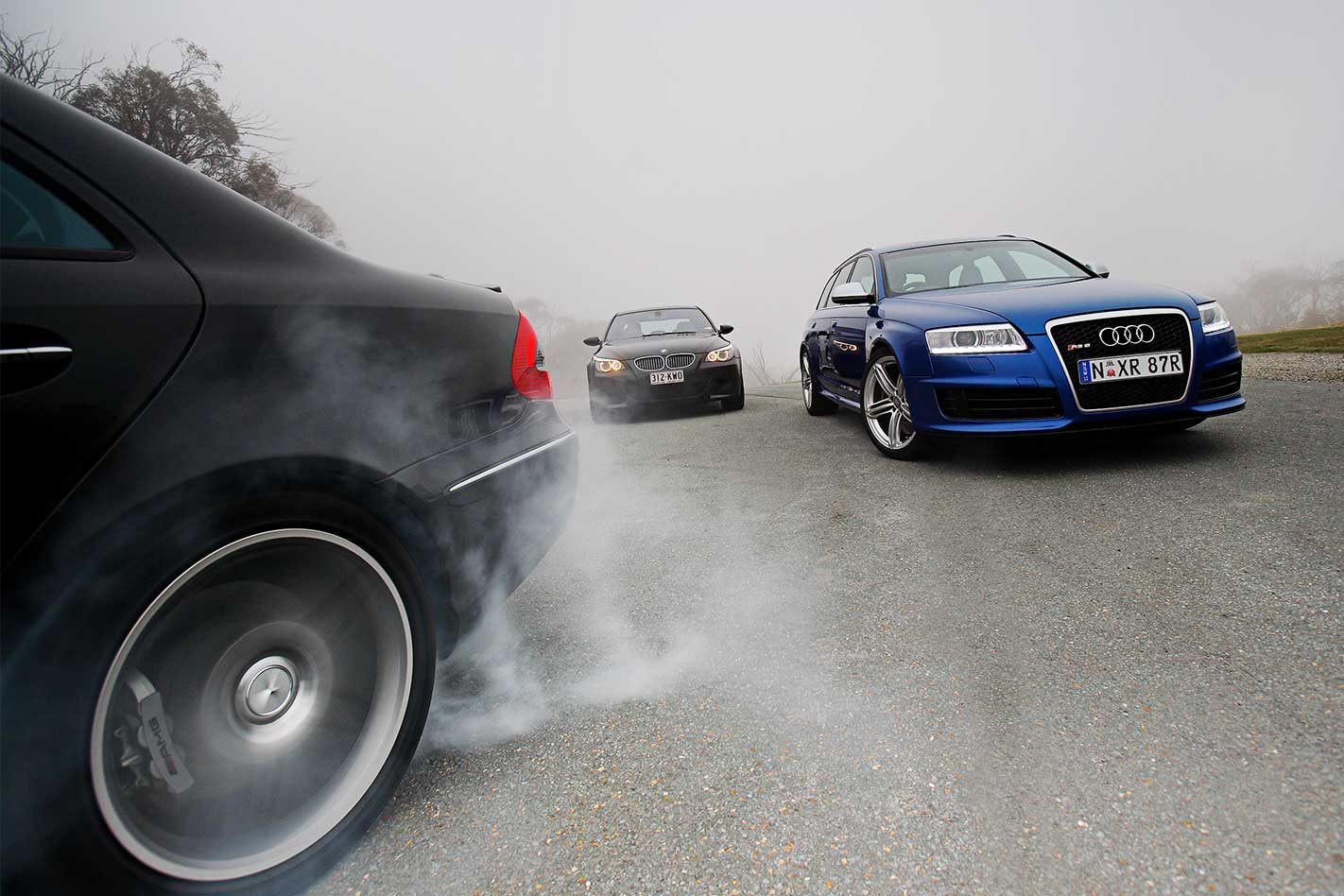Bad, it seems, has a new name, and we’re not talking underworld crims here, or three-year-olds with behavioural disorders. The subject in this instance is the very antithesis of the word’s true meaning, but with enough firepower to intimidate just about anything on earth, bullying has just been elevated to whole new level.
This feature was originally published in MOTOR’s December 2008 issue
We’re talking Audi’s new-generation RS6 – freshly minted with an extra two pistons and 819cc more capacity than the glorious twin-turbo V8 original. In 2004, 331kW seemed sufficient enough to achieve just about anything, but in power-hungry 2008, nothing less than a genuine 500hp (or 373kW) is worth getting out of bed for. So, wake up world because the new RS6 is blessed with 426 metric big ones.

Incredibly, Ingolstadt’s bi-turbo V10 is doing it easy.
In the power-output hierarchy, the uber-Audi reigns supreme over its long-held nemeses – BMW’s M5 and Mercedes-Benz’s E63 AMG. Neither the Bee-Em (373kW) nor the Benz (378kW) are in quite the same league, though the Munich mauler – with the same engine displacement as the Audi – nails 500 horsies without having to resort to forced induction.
The Stuttgart slayer goes just five kilowatts better, despite an additional 1.2 litres of capacity, but uses its size to unleash 630Nm of torque – 110 better than the BMW, at 900 less revs, but still thousands over the Audi’s bottom-end beef benchmark.
The RS6 makes do with six forward ratios while the BMW and Mercedes each have seven, but it isn’t the gear count that squeezes the outright performance of this trio to within a toddler’s tootsie of each other. It’s weight.
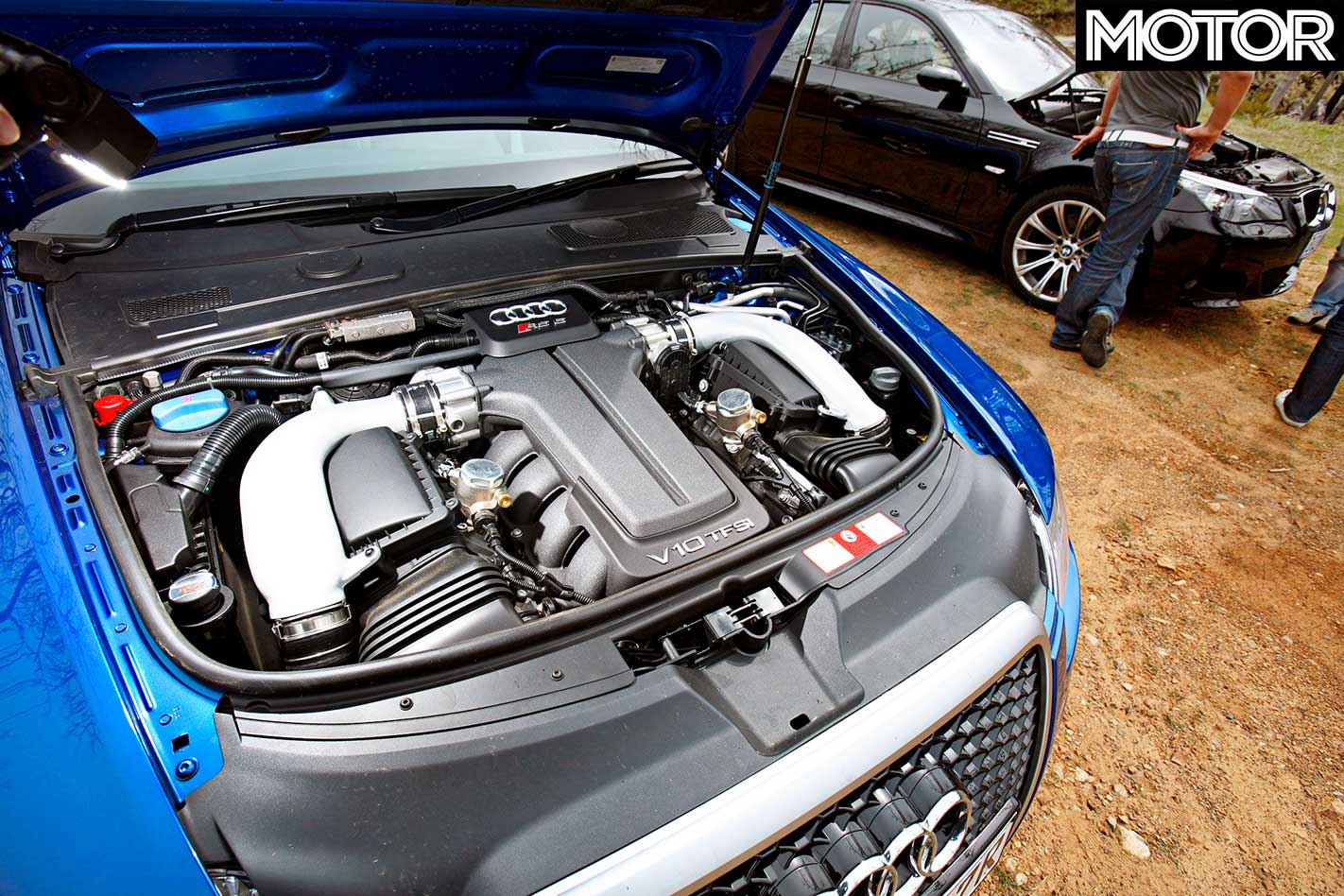
The rear-drive M5 (1755kg) and E63 (1765kg) each do a commendable job of keeping their kilo-count relatively low, but the all-wheel-drive RS6, admittedly in Avant station-wagon form, scales in at a downright obese 2025kg.
Measured by power-to-weight, the Audi (with 210kW/tonne) actually concedes bragging rights to both the Mercedes (214kW/tonne) and the BMW (213kW/tonne), though in reality you couldn’t ask for a closer, more adrenaline-pumping straight-line fight.
As you’d expect, Audi’s big-power, all-wheel-driver grabs the initial advantage. ESP/ASR off, gear lever into the +/- gate (where it revs slightly higher than in D or S), load-up on the brake, then release.
And prepare to be momentarily underwhelmed. There’s no spiking of revs, spooling-up of tyres, or squirming under the pressure of it all. The RS6 simply saunters forward while reflecting on what’s about to happen, then explodes. And never lets up until it lurches into its 250km/h speed limiter.
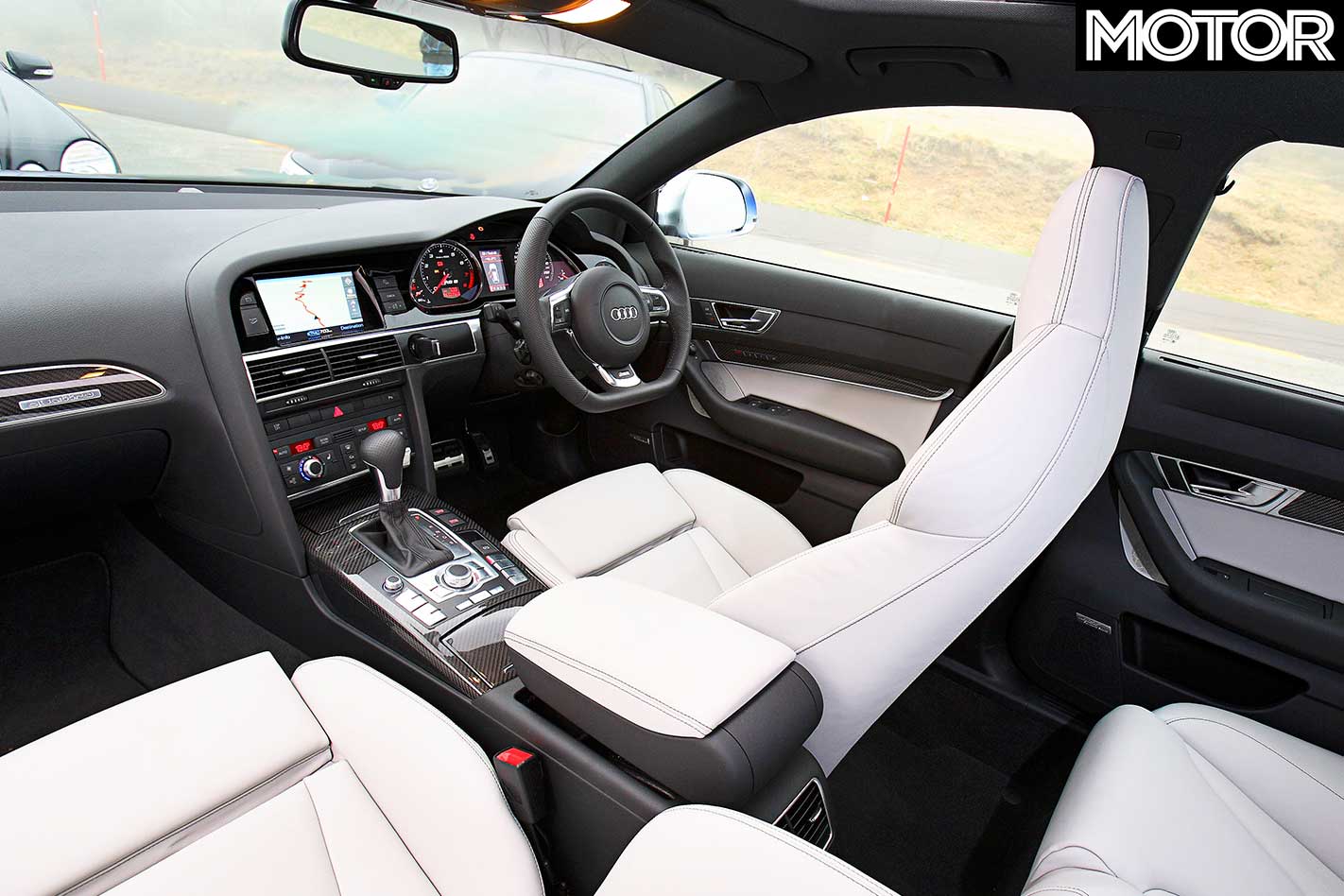
On light throttle under 2500rpm, the RS6 emits an uninspiring, one-dimensional exhaust drone that sounds depressingly dull, but get stuck into it and the engine immediately transforms into the meaty, snarling 10-pack that it is.
The tacho needle doesn’t quite reach the 6700rpm redline before an upshift occurs, but that’s of little consequence when you’re eating bitumen with such intensity, accompanied by VW/Audi’s now-trademark exhaust blurt as the RS6 snatches the next gear.
Thing is, and this is hard to believe, the RS6’s accelerative firepower is actually quite deceptive. The bi-turbo V10’s bark is more subdued than you’d expect – sounding neither as crisp as the M5’s strident V10 or as emotive as the old RS4’s V8 with ‘S’ button engaged. And the chassis’s grip is so immense that putting all that power to the ground is amazingly drama free – one of the great advantages of all-wheel-drive and 275/35R20 Pirelli P Zeros!
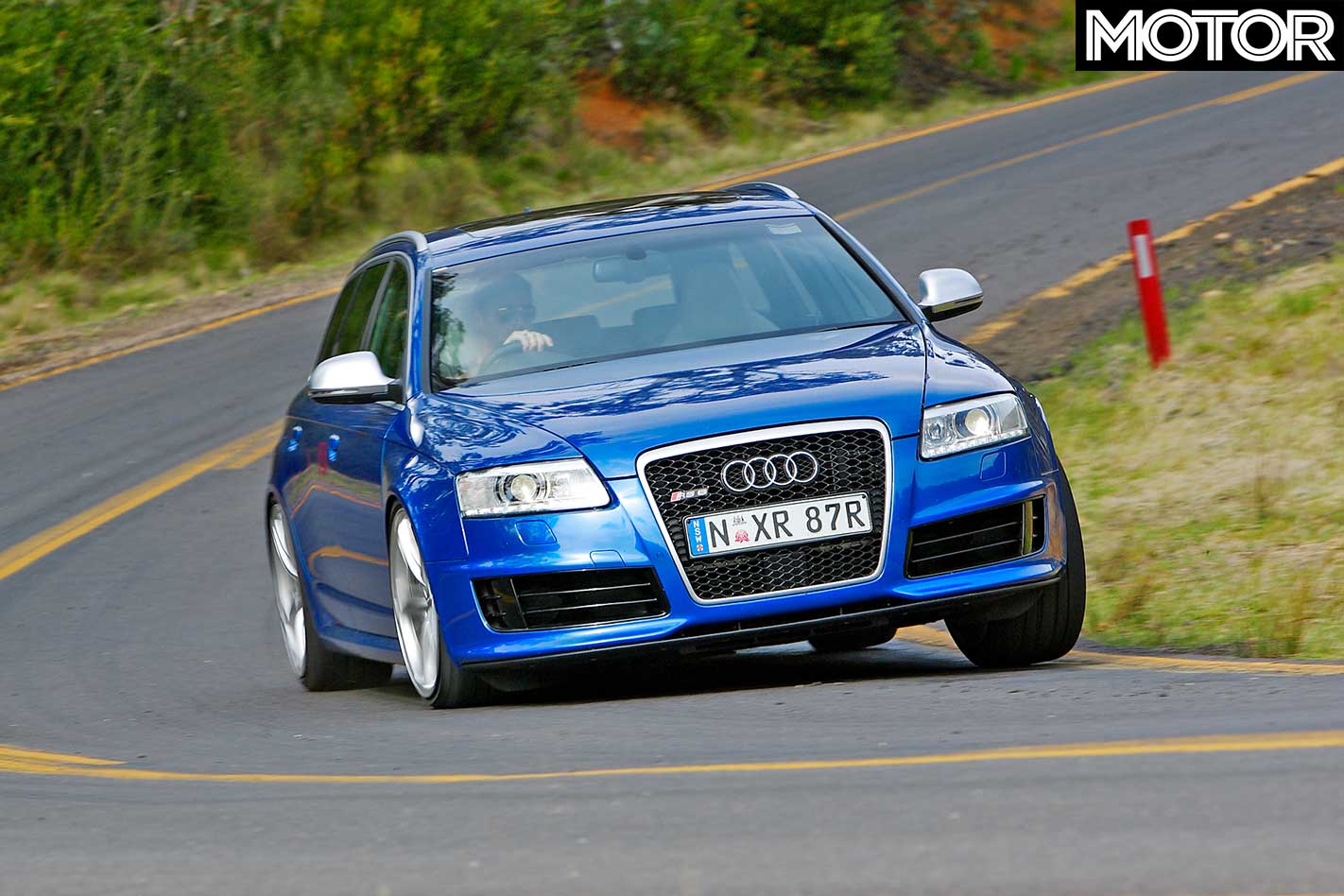
The Mercedes and BMW are within a body-length of the Audi’s oval rear pipes, however. Both rear-drivers have to be walked off the line to prevent big-time wheelspin – the BMW’s launch control proving wincingly brutal and utterly useless, as per usual.
The RS6 nails 60km/h in 2.36sec while the Benz takes 2.64 and the BMW 2.77, but to 100km/h, the Benz’s 4.74sec and the Beemer’s 4.83sec aren’t too far adrift of the Audi’s blistering 4.53.
By 160km/h, the M5 is just two-tenths behind the RS6, with the E63 starting to lose ground, and beyond 190km/h, the BMW actually surges ahead – demonstrating the M-sedan’s ferocious top-end and searing high-speed pace. Not that any of this is relevant anywhere in Australia, but it’s worth knowing all the same.
Entirely applicable, though, is their overtaking punch. From 80 to 120km/h in Drive, both the RS6 and E63 nail the increment in just 2.6sec, but held in third (of its sequential box’s seven speeds) the M5 isn’t far behind at three-dead. Take into account that second gear in the BMW actually extends beyond 110km/h and you’ll find that once moving, it’s actually the fastest car here. And the best-sounding.
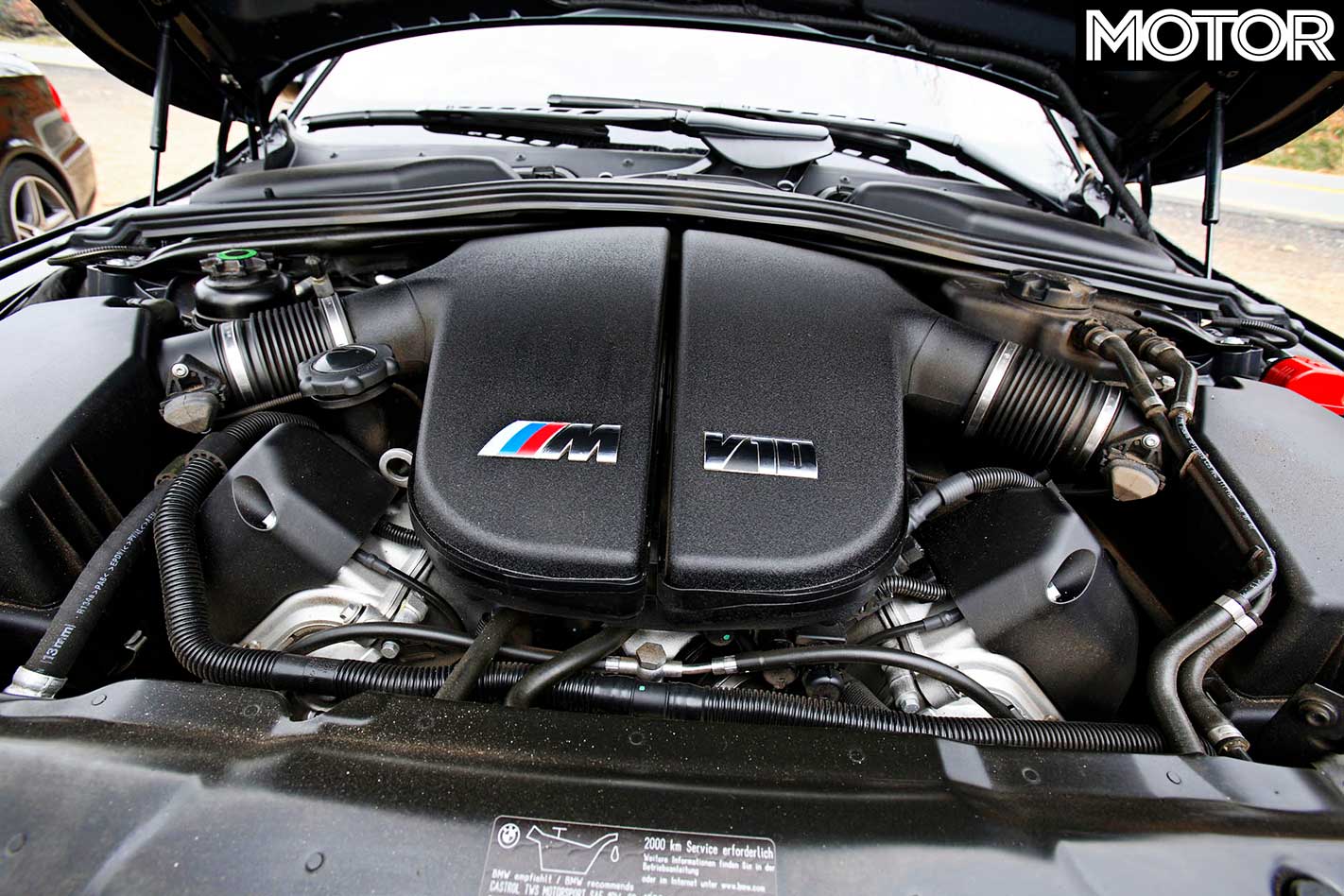
BMW’s rev-hungry 5.0-litre V10 might max out at 8400rpm – 1000 revs higher than the AMG, and 1600 more than the RS6 – but it’s an incredibly tractable engine for something so highly strung. Even at the bottom end of its vast rev range, a warbling 10-pot grumble pervades the M5’s cabin as it channels the impressive 450Nm it’s already producing at 3500rpm. But the hardcore action lies above five-and-a-half.
Not only does the tone of the V10’s metallic warble shift up several notches, but so does the ferocity of its acceleration as it blitzes past max torque (at 6100rpm), then max power (7750rpm). The more committed your right foot, the faster the BMW gets, though its 374mm front brakes, like the E63’s smaller 360mm rotors, can’t match the supreme feel, confidence and stopping force of the RS6’s massive 390mm vented discs.
In the Audi, you barely have to flex your right toe to stoke it. With so much torque at so few revs, the bi-turbo V10 redefines what ‘torquey’ means, making throttle response absolutely instantaneous. And driving it in anything other than Drive pretty much completely redundant.
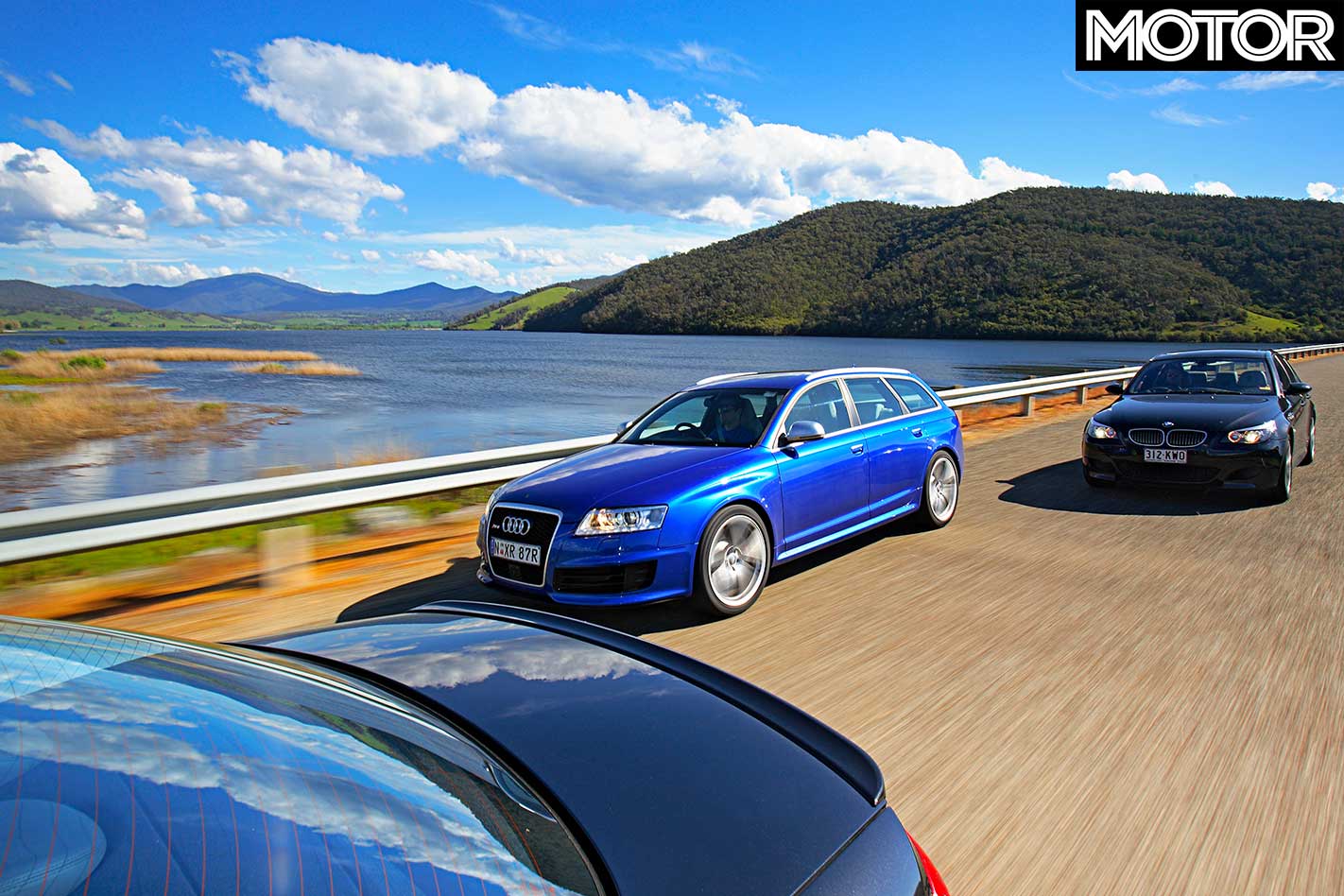
The only downside to this is there’s no natural progression on very light throttle inputs, making driving at a steady crawl like trying to be subtle with a light switch. There’s also the aforementioned exhaust drone at sleep-inducing speeds, which is something the BMW and Mercedes quad-pipe systems wouldn’t dare emit.
From the moment we first tried AMG’s 6.2-litre V8 in the E63 nearly two years ago, it was instant lust. It’s a tremendously strong, flexible powerplant – as happy rumbling along at 1500rpm in seventh as it is howling towards its 7400 cut-out – and is the very heart and soul of the E63.
Nail the right pedal near a concrete road divider with a window cracked and its V8 Supercar soundtrack is champagne for the ears – yours and everybody else’s in the near-vicinity. But now that we’ve tried the facelifted SL63 and CLS63, both running AMG’s sports exhaust system as standard, the E63’s muted crackle on overrun and subdued rumble at freeway speeds just aren’t what wet dreams are made of anymore.
And there’s its transmission. The E63’s 7G-Tronic is great at picking the right gear, and great in manual mode with its wheel shift-paddles and ability to hold the driver’s selection, but it’s inferior to the new ‘Speedshift Plus’ version in the CLS63.
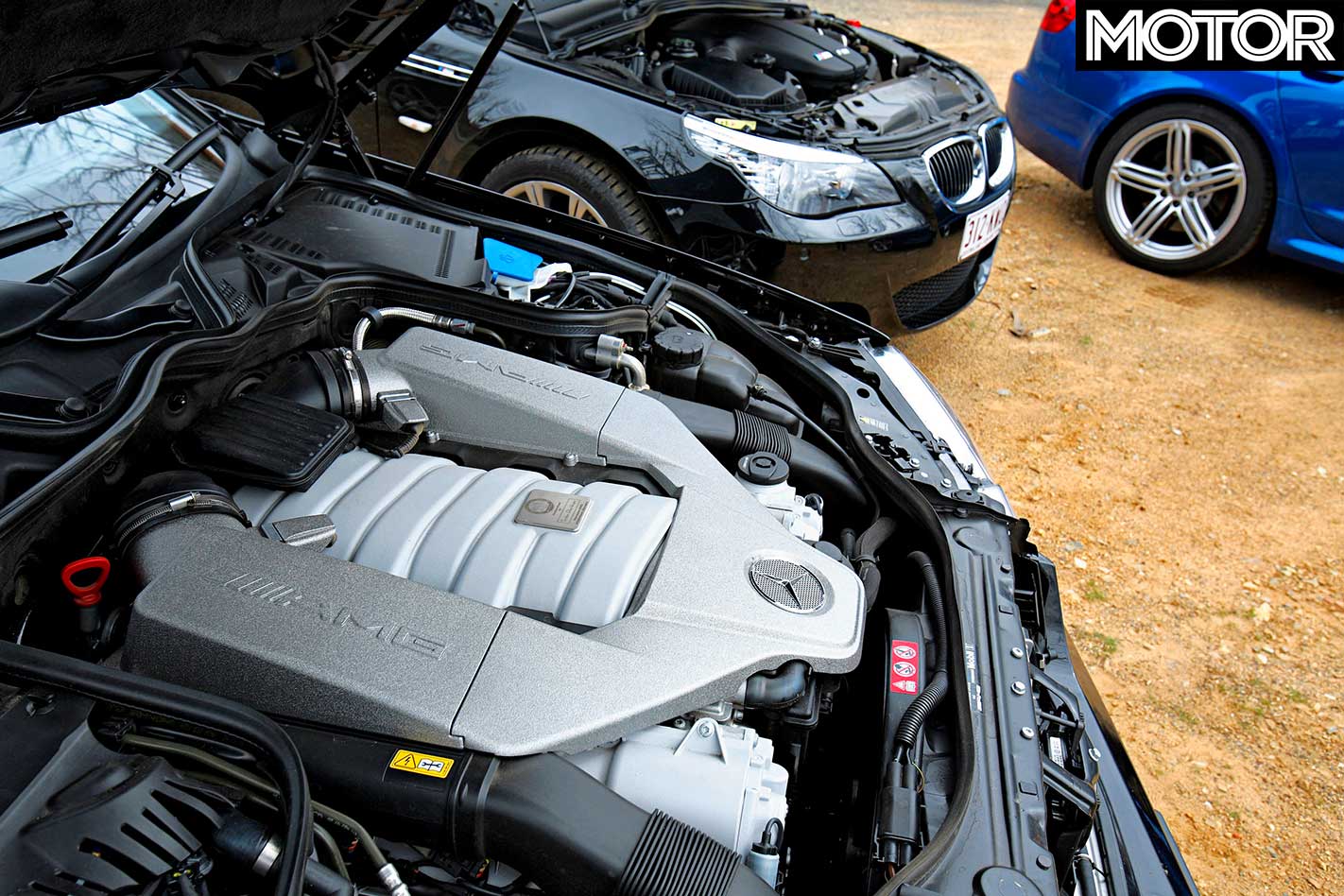
Where the Speedshift seven-speeder blips the throttle seamlessly and seductively on downshifts, both in Manual and Sport modes, the E63’s version does neither. Not only is it slow to respond to a downshift request, but by not matching revs, it can actually unsettle the balance of the car – particularly on a racetrack.
BMW’s SMG gearbox and Audi’s new-generation six-speed auto both blip the throttle on downshifts with precision. The traditional auto in the RS6 borders on flawless in its operation, no doubt helped by all that torque, but the M5’s sequential unit is a definite mixed bag. Simply put, in auto mode, regardless of what shift program you select (and there are five), it’s rubbish. Changes are lumpy and poorly timed, and almost embarrassing.
But if you treat it as a robotised manual and do all the gearshifting yourself (in either setting four or five – six is DSC-off only and suitable only for track work or performance testing), then the third-generation SMG ’box is, well, fine, proving both smooth and reasonably swift.
BMW has pretty much always held the high-ground when it comes to dynamics, while Audi and Mercedes have often missed the mark. But in this instance, all three are more than capable of thrilling the enthusiast.

The RS6 is the unknown quantity, of course, though anyone familiar with the old RS4’s set-up will recognise the 40/60 front-to-rear drive bias (in normal conditions) and the Dynamic Ride Control (DRC) system that interconnects diagonally opposed dampers via oil lines and a central valve.
The Torsen centre differential can send up to 65 percent of drive to the front or 85 percent to the rear, enhancing the RS6’s solid balance and its staggering corner-exit wallop, but it’s DRC that arguably makes the biggest difference to the RS6’s dynamics.
Not only does DRC make the RS6 ride far better than the brittle S6, but it sends fluid to a compressed outside damper when cornering to reduce body roll. Indeed, the RS6 sits flatter than a squashed cane toad in hard cornering and that’s with its three-stage ‘sports suspension plus’ dampers (optional in Europe but standard in Oz) set to Comfort.
Like the three-stage damping set-ups in the BMW and Mercedes, selecting the firmest setting (‘Dynamic’ in the RS6, ‘Sport II’ in the E63, ‘Sport’ in the M5) is all but useless unless you’re on perfect hotmix bitumen or on a racetrack, but in the RS6, the stiffer the setting, the lesser the understeer. Yes, ultimately the mega-Audi can’t disguise its front-biased weight distribution or its engine location ahead of the front axle line.
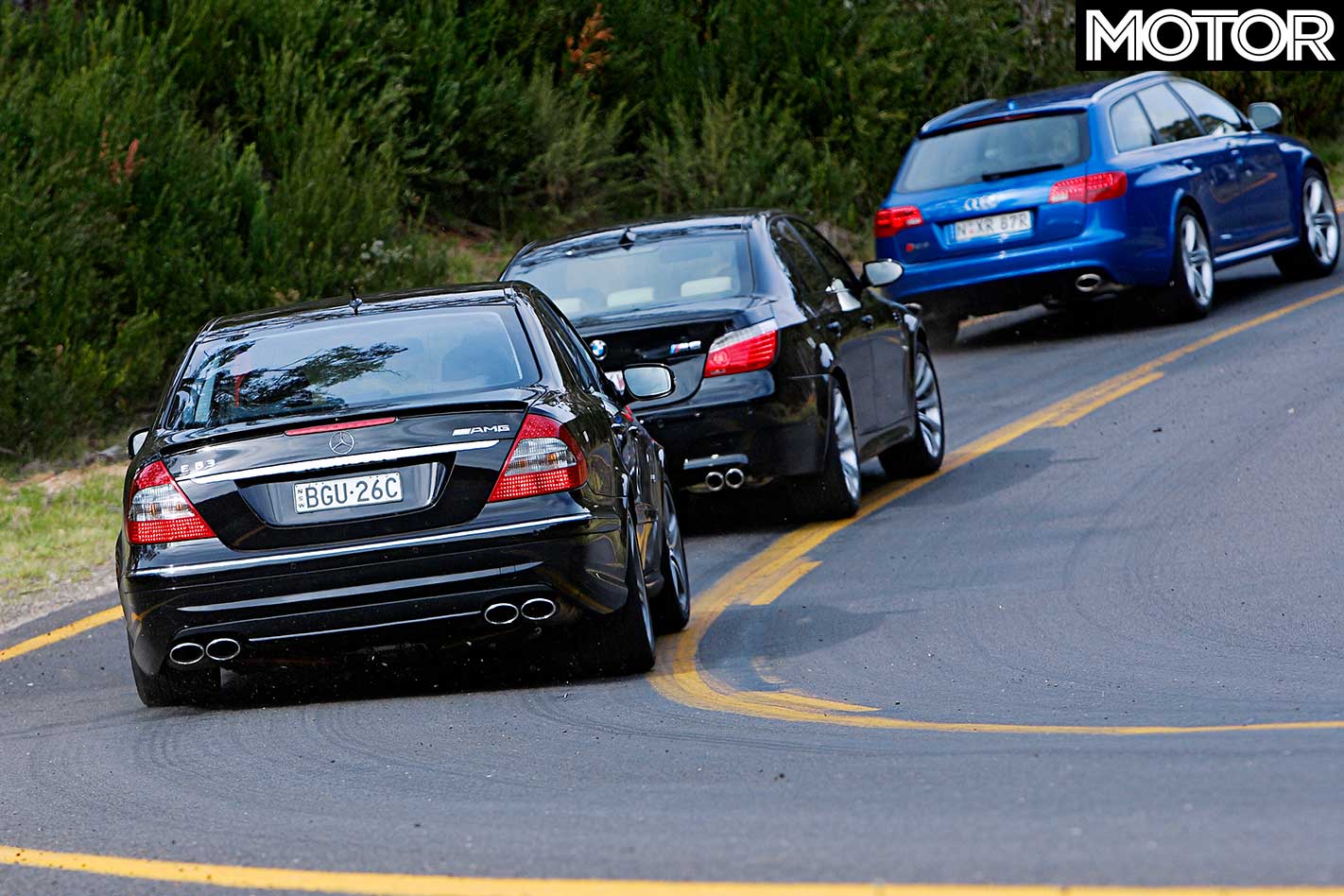
But it does a mightily impressive job in coping with it – no doubt helped by its buxom track widths (1614/1637mm front-to-rear versus the E63’s 1567/1588 and the M5’s 1580/1566). The RS6’s nose bites well when trail-braked into a corner, and as long as you’re aware of its preferred slow-in, fast-out technique, then you’re onto a winner.
Flatten the RS6’s right pedal once you’ve settled its balance and it absolutely launches forward, drifting its tail out slightly while putting its power down brilliantly. Push too deep or hard into a turn and the RS6 inevitably understeers, but not as much as you might expect. And it steers reasonably well, too, with a fair amount of heft via its great-to-hold three-spoker, but precisely and progressively, despite just 2.3 turns lock-to-lock.
The E63’s steering is even heavier than the RS6’s (arguably too heavy, actually), and its steering wheel is awful. While the rim is actually quite compact (with yet another annoying squared-off bottom), the airbag is bulky and obstructive and the perforated leather and exposed stitching feel rough – in complete contrast to the supple tactility of the RS6 and M5 tillers.
The E63 is difficult to guide through really tight corners (as on our NSW Snowy Mountains test loop) because your thumbs ache as your hands try to grapple with the clumsy wheel design, and its steering column is offset, too – sitting well to the left of a seat with a small, relatively stingy cushion, but with an amply supportive backrest.

Unfortunately, it’s this compromised driving position and offensive steering interface that undermines the E63’s solid dynamic ability. Its balance is impressive and it displays better front-end grip and feel with its dampers in mid-level ‘Sport 1’ than the M5 in its comparative setting. The E63’s steering actually has more feel than the Audi’s, though it loads up and kicks back if pushed hard over corrugations.
And it’s also clearly quieter than both its rivals, particularly in terms of tyre noise. Despite its age, refinement remains the E63’s hallmark – exhibiting the least wind, road and tyre noise of the three – and its ride is the flattest and most absorbent with its dampers set to Comfort. It also has the best vision, particularly over its low-cowl dash and past its slim A-pillars.
Jumping into the M5 after the E63, you instantly notice its superb seats, lovely steering wheel and great driving position. Do the same after driving the RS6 and it’s the BMW’s lithe agility and terrific steering that you notice most.
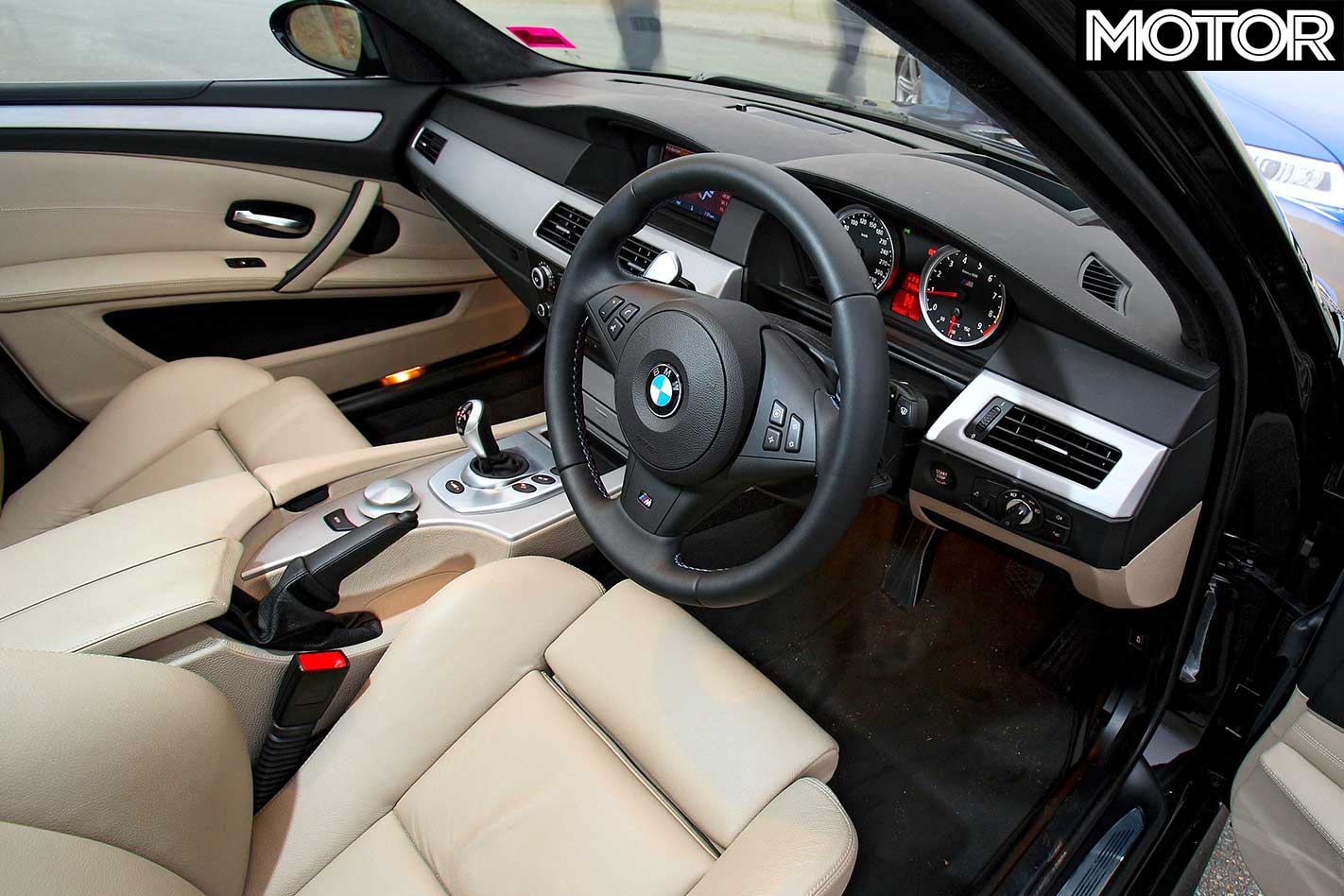
Indeed, both the E63 and M5 feel much lighter than the Audi, but it’s the BMW’s crisp, communicative steering that enhances the sensation. The M5 is also more throttle adjustable than either of its rivals, making it the driver’s choice for handling, steering and balance, but its Comfort damper setting allows a little too much vertical movement on undulating roads at speed, where the E63 and RS6 feel tighter and more composed. More so than its rivals, the M5 is better off in its mid suspension setting most of the time.
You’d have to be a miserable, melancholy, mop-fringed suicide case not to raise a smile at the prospect of steering any of these German superstars. They all make you feel special, in entirely different ways, but when a pecking order beckons, it’s the E63 that must leave the competition first.
The sinister Mercedes still has pace, presence and refinement in copious gob-fulls, and dynamically, it can still show the BMW and Audi how certain things should be done. It’s also clearly the most economical – drinking over 10 percent less fuel than the RS6. But with under a year left until retirement, and nearly seven under its belt, the W211 AMG E-class is ageing fast.
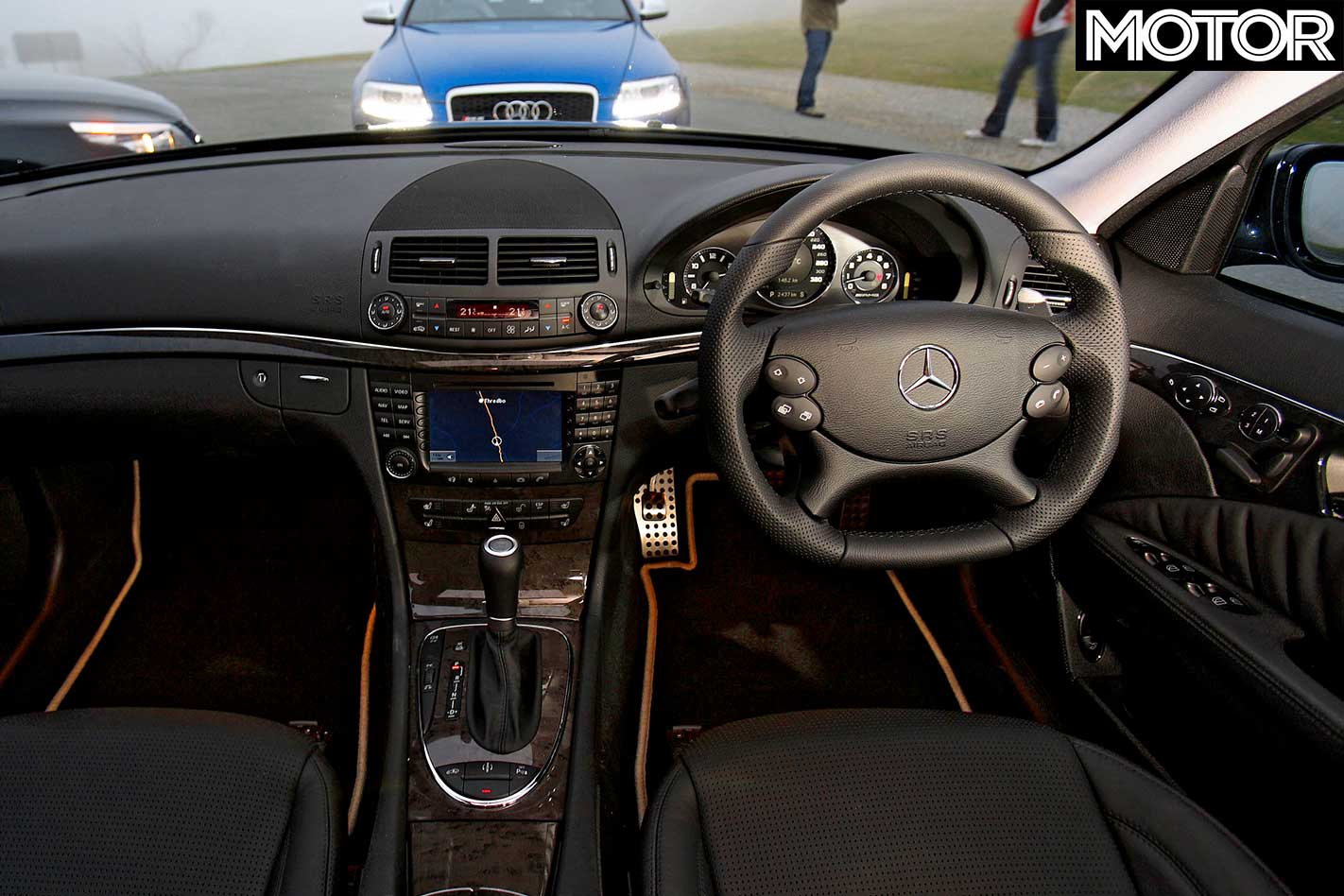
If it had the CLS63’s slimmer steering wheel, smarter transmission and sexier exhaust crackle, it would be incredibly hard to dismiss, but it’s all a bit late in the model cycle for that now. Realistically, if you could stump up the extra 30 grand for a CLS63 AMG, you’d be mad not to. If room was paramount, there’s always the E63 Estate. Or you could simply save a truckload and buy the brilliant, though much smaller C63 AMG.
The M5 and RS6 are harder to separate. Neither is as refined or rides as well as the E63, but they’re much more comfortable to sit in and steer. The BMW has its flaws – the SMG gearbox is atrocious in auto mode, its interior is fussy, and its suspension is least happy in Comfort mode. But it’s also much lighter than the RS6, has easily the best steering, the most adjustable handling and the best seats. It’s also $30,000 cheaper than the uber-Audi, though whether that matters at this price point is a personal matter.
The RS6 comes across as a bigger, chunkier, less-animated RS4. In the hierarchy of Audi’s range, it’s so much better the regular A6 and S6 that it feels like a different car – just like the fabulous RS4 did over the underdone old-gen A4 and S4.

It has very few downsides – weight and price being the main two – and a level of interior class that simply takes your breath away, with but it also doesn’t quite achieve the passion-tingling highs of its rivals. It has the heart of Tyrannosaurus Rex and the stance of a front-row forward, and is undoubtedly ‘bad-arse’ on so many levels, but you just wish it was that little bit nastier.
So, the RS6’s huge competence or the M5’s heroic character? If your lounge room looks like a Space furniture catalogue and you’ve had a feng shui expert tell you where to put stuff, you’ll love the RS6 to bits. Certainly we do – mostly. But if you like your life to be spontaneous, exciting, and just a little bit chaotic, the M5 remains the true definition of bad. It’s still a very naughty boy.
Fast Facts
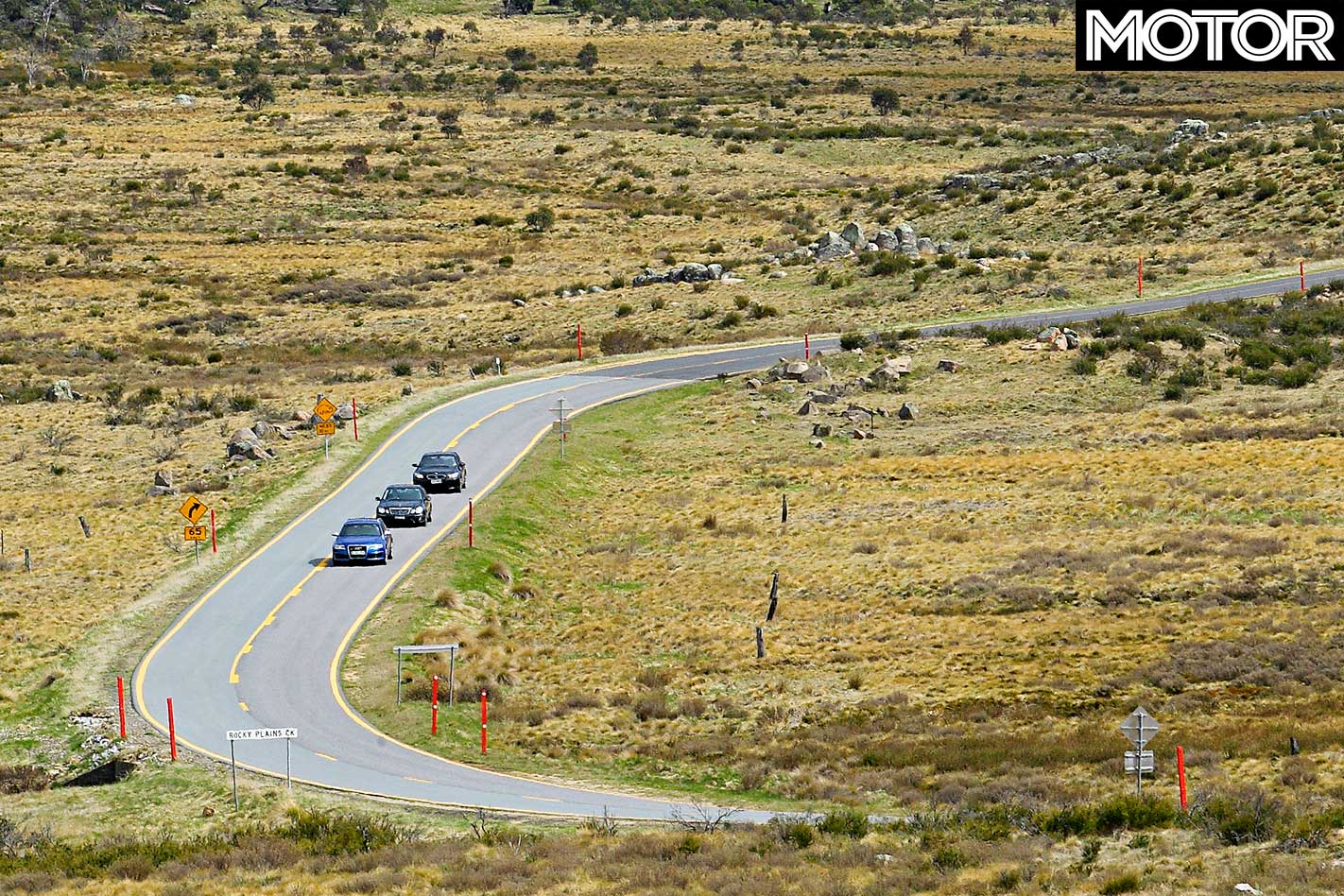
| u00a0 | Audi RS6 Avant | BMW M5 | Mercedes-Benz E63 AMG |
| Body | 5-door, 5-seat wagon | 4-door, 5-seat sedan | |
| Drive | all-wheel | rear-wheel | |
| Engine | 4991cc 90-degree V10, DOHC, 40v, twin-turbo, twin intercoolers | 4999cc 90-degree V10, DOHC, 40v | 6208cc 90-degree V8, DOHC, 32v |
| Bore x Stroke | 84.5mm x 89.0mm | 92.0mm x 75.2mm | 102.2mm x 94.6mm |
| Compression | 10.5:1 | 12.0:1 | 11.3:1 |
| Power | 426kW @ 6250-6700rpm | 373kW @ 7750rpm | 378kW @ 6800rpm |
| Torque | 650Nm @ 1500-6250rpm | 520Nm @ 6100rpm | 630Nm @ 5200rpm |
| Power/Weight | 210kW/tonne | 212kW/tonne | 214kW/tonne |
| Transmission | 6-speed automatic | 7-speed sequential manual | 7-speed automatic |
| Weight | 2025kg | 1755kg | 1765kg |
| Suspension (f) | multi-links, coil springs, adaptive dampers, anti-roll bar | struts, A-arms, adaptive dampers, anti-roll bar | double A-arms, air springs, adaptive dampers, anti-roll bar |
| Suspension (r) | multi-links, coil springs, adaptive dampers, anti-roll bar | multi-links, air springs, adaptive dampers, anti-roll bar | |
| L/W/h | 4928/1889/1460mm | 4855/1846/1469mm | 4881/1822/1465mm |
| Wheelbase | 2846mm | 2889mm | 2854mm |
| Tracks | 1614mm (f);1637mm (r) | 1580mm (f); 1566mm (r) | 1567mm (f); 1588mm (r) |
| Brakes (f) | 390mm ventilated discs, six-piston calipers | 374mm ventilated/drilled discs, twin-piston calipersu00a0 | 360mm ventilated/drilled discs, six-piston calipers |
| Brakes (r) | 365mm ventilated discs, single-piston calipers | 370mm ventilated/drilled discs, single-piston calipers | 330mm ventilated/drilled discs, four-piston calipers |
| Wheels | 20 x 9.5-inch (f/r) | 19 x 8.5-inch (f),u00a019 x 9.5-inch (r) | 18 x 8.5-inch (f), 18 x 9.5-inch (r) |
| Tyres | Pirelli P Zero; 275/35ZR20 (f/r) | Continental Sport Contact 2; 255/40ZR19 (f), 285/35ZR19 (r) | Continental ContiSportContact3; 245/40ZR18 (f), 265/35ZR18 (r) |
| Price | $270,946 ($277,355 as tested) | $241,816 ($246,644 as tested) | $238,956 ($245,979 as tested) |
| Pros | Impressive all-rounder, mega torque, mega grip, mega quality | Best noise, best steering, best seats, most adjustable handling | Excellent ride/handling combo, great V8, polished refinementu00a0 |
| Cons | Expensive, heavy, not quite the temptation the RS4 Avant was | More road noise than E63, SMG u2019box rubbish in auto mode | Awkward steering wheel, auto doesnu2019t blip on downshifts |
| Rating | 4 out of 5 stars | 4 out of 5 stars | 3.5 out of 5 stars |
The Strip
| u00a0 | Audi RS6 Avant | BMW M5 | Mercedes E63 AMG |
| 0-10km/h | 0.29sec | 0.43sec | 0.58sec |
| 0-20km/h | 0.72sec | 0.95sec | 1.03sec |
| 0-30km/h | 1.13sec | 1.47sec | 1.45sec |
| 0-40km/h | 1.47sec | 1.90sec | 1.84sec |
| 0-50km/h | 1.83sec | 2.35sec | 2.24sec |
| 0-60km/h | 2.36sec | 2.77sec | 2.64sec |
| 0-70km/h | 2.91sec | 3.39sec | 3.11sec |
| 0-80km/h | 3.44sec | 3.78sec | 3.62sec |
| 0-90km/h | 3.99sec | 4.30sec | 4.15sec |
| 0-100km/h | 4.53sec | 4.83sec | 4.74sec |
| 0-110km/h | 5.33sec | 5.58sec | 5.47sec |
| 0-120km/h | 6.10sec | 6.27sec | 6.20sec |
| 0-130km/h | 6.92sec | 7.01sec | 6.97sec |
| 0-140km/h | 7.72sec | 7.78sec | 7.79sec |
| 0-150km/h | 8.57sec | 8.58sec | 8.70sec |
| 0-160km/h | 9.42sec | 9.61sec | 9.79sec |
| 0-170km/h | 10.46sec | 10.67sec | 10.93sec |
| 0-180km/h | 11.64sec | 11.73sec | 12.09sec |
| 0-190km/h | 12.83sec | 12.80sec | 13.28sec |
| 0-200km/h | 14.08sec | 13.93sec | – |
| 0-400m | 12.58sec @ 188.1km/h | 12.82sec @ 190.2km/h | 12.83sec @ 186.3km/h |
| 80-120km/h (Drive) | 2.6sec | 3.0sec | 2.6sec |
E-Class AMG or CLS?

If you need to seat five, then the answer’s obvious – E63. But despite a small weight disadvantage (65kg), the just-facelifted CLS63 is actually a better car. Not only does it share its new-design, round AMG three-spoke steering wheel with the SL63, but it also gets the roadster’s luscious sports exhaust, too. So not only can you get a decent grip of the CLS63’s wheel, but it hollers a V8 exhaust crackle worth bottling. And its revised ‘Speedshift Plus’ auto blips the throttle on downshifts. Mix that ability with the glorious, burbling gargle on overrun and you won’t need convincing.
M5 Touring Coming?
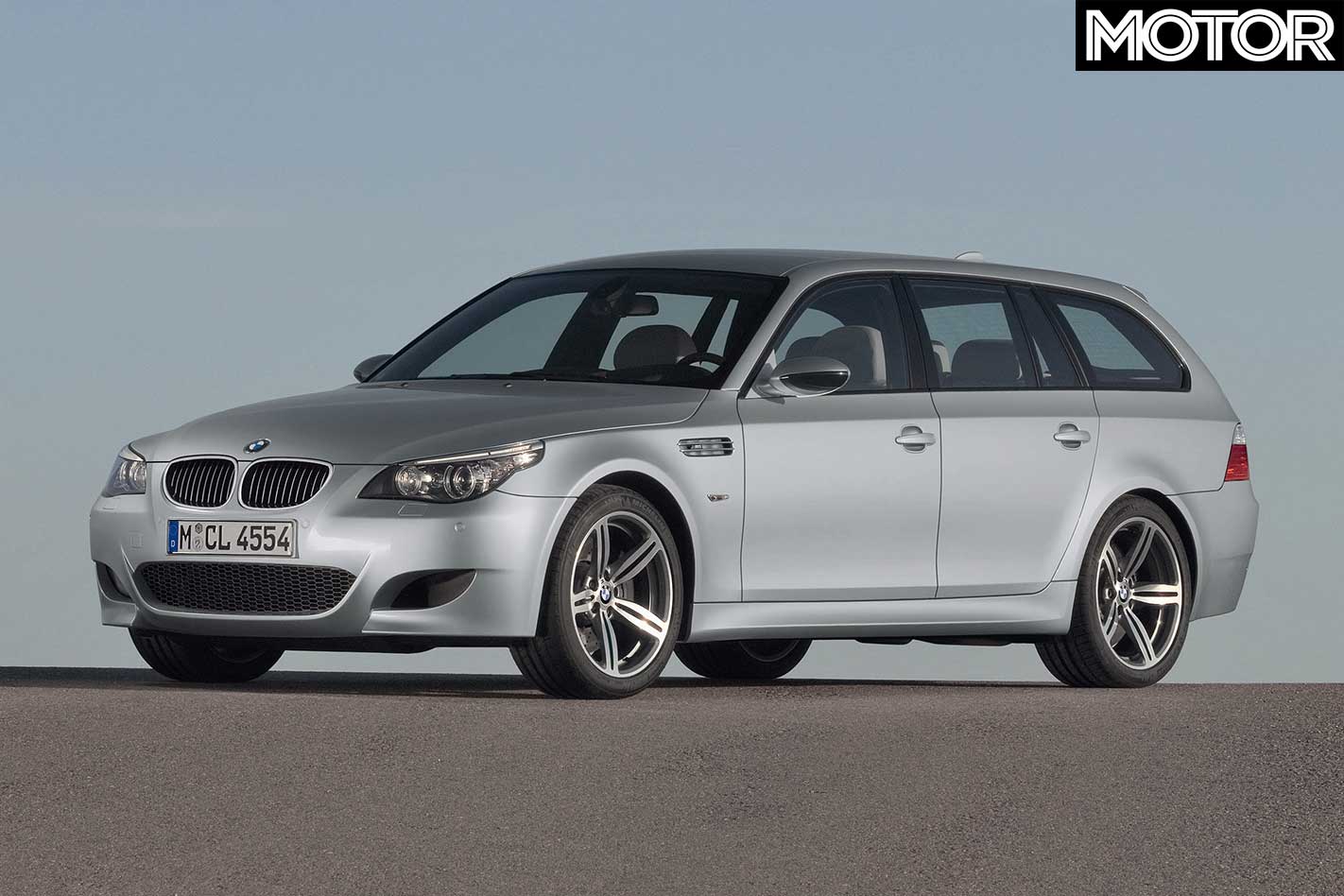
It’s been on sale in Europe since 2006, but the M5 Touring still isn’t on the boat to Australia. BMW Oz reckons it wouldn’t sell enough to justify the hassle and cost of shipping them here, which is a pity because the wagon is easily the best-looking E60 5 Series variant, and that applies doubly to the M5 version (see below, complete with the M6’s alloys). You’d hear more exhaust noise through the rear floor, too, which would sweeten the deal.

